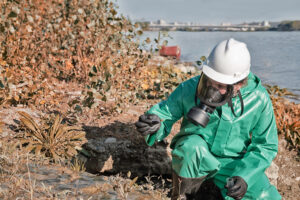Radon gas in the workplace and employers’ obligations
Every area and building has a degree of radon, although in most areas levels are low, and there are legal requirements relating to employers’ obligations to test radon levels, and these vary according to the location of the property.
As most radon we are exposed to comes from the ground this includes whether the workplace is situated above or below ground.
The Health and Safety at Work Act 1974 requires employers to ensure the health, safety and welfare of their employees as well as those that have access to their place of work, so far as is reasonably practicable. The Management of Health and Safety at Work Regulations 1999 require the assessment of health and safety risks to include radon1. According to a review published in 2016 by Public Health England, throughout 2010, 48% of our exposure to radiation came from radon gas from the ground2.
Workplaces both above and below ground, require appropriate risk assessments, which include radon measurements, to be carried out1.
If the workplace is above ground a risk assessment should be carried out if it is situated within a radon affected area, with radon measurements taken from appropriate ground floor rooms. The indicative radon atlas (https://www.ukradon.org/information/ukmaps) can be used to ascertaining if a property is in a radon affected area, though this is more conservative due to being at 1km resolution, or by purchasing reports that include the higher resolution dataset which is more specific.
A risk assessment for radon should always be carried out when a workplace is below ground and is utilised or occupied for more than 50 hours per year (basements, cellars, mines, caves, tunnels, etc.), or contains an open water source1,2.
Workplaces that only occupy parts of buildings located in the first floor or higher are less likely to be subject to significant levels of radon when compared with those at or below ground level.
Testing for Radon
Given that workplaces can vary wildly in all sorts of ways, the number of monitors that should be used to provide an accurate assessment can also vary. Information on how many monitors should be used for different types of workplaces can be found here on UK Radon’s website https://www.ukradon.org/information/workplace.
In the event that radon levels are determined to be above 300 becquerels (Bq/m3) (as an annual average), the Ionising Radiations Regulations 2017 would come into effect, requiring employers to take immediate action to restrict exposure. This can be done by engineered means which may involve consulting with a specialist radon removal (remediation) contractor, or by managing occupational exposure which should involve consultation with a Radiation Protection Adviser with radon experience1,3.
If below 300 Bq/m3, the employer should make a decision on how often the risk assessment is to be reviewed, however, the Health and Safety Executive advises the following1:
- “Where radon levels were found to be significantly less than 300 Bq/m3 at the initial measurement, the period of remeasurement might be of the order of once every 10 years;
- “Where radon levels were just below 300 Bq/m3 at the initial measurement, the suggested period for remeasurement will be less than 10 years;
- “Where radon levels were above 300 Bq/m3 at the initial measurement and measures have been taken to reduce radon exposure (such as engineered systems or occupancy restrictions), the remeasurement periods may need to be significantly more frequent in order to verify their continuing effectiveness.”
A review of the risk assessment should also be undertaken when changes are made to the fabric of the building or the activities undertaken.
What does this mean for valuers, lenders and conveyancers?
The RICS Valuation – Professional Standards UK Appendix 3.2 RICS mortgage valuation specification states that the valuer’s inspection should deal with a number of matters relevant to the subject property, including radon.
Where the valuer becomes aware of the presence of radon gas, reference should be made to the guidance in UKGN1 which states:
“When valuing property in these areas, it would be prudent to enquire if any test has been carried out. If not, or if the results are not available, the valuer should recommend that one be commissioned”4.
This valuer’s report subsequently feeds into the lender’s decision-making processes and where the potential for elevated levels of radon gas is identified, the lender may require further investigations to be carried out prior to deciding to lend.
In turn, this can cause delays for conveyancers handling the transaction. When this is the case an option that can be pursued is to put a retention in place, often referred to as a Radon bond. This is an agreed sum of money put aside to pay for any remediation required after the test and analysis has been completed5. While remedial costs for commercial premises are heavily dependent on type and size of workplace, they can be between £2,500 and £10,000, and can be up to £15,000 in some circumstances. If the results are below the Action Level the money is passed on to the seller. Alternatively, if they are above the Action Level the funds are used to pay for remedial works, with the remainder going to the seller.
Radon is a core element of an environmental search and is included as standard in all Groundsure commercial (and residential) searches. To find out more about our product portfolio visit www.groundsure.com/search-reports.
References:
1. The Health & Safety Executive (2019). Radon in the workplace (online). UK, http://www.hse.gov.uk/radiation/ionising/radon.htm, accessed 10th May 2019.
2. Public Health England (2016). Ionising Radiation Exposure of the UK Population: 2010 Review. Crown Copyright.
3. Public Health England (2019). Radon in the workplace (online). UK, https://www.ukradon.org/information/workplace, accessed 10th May 2019.
4. Royal Institution of Chartered Surveyors (RICS) (2014). RICS Valuation – Professional Standards UK January 2014 (revised April 2015). Copyright Royal Institution of Chartered Surveyors (RICS), London.
5. Public Health England (2019). Radon and house sales (online). UK, https://www.ukradon.org/information/housesales, accessed 10th May 2019.
Kindly shared by Groundsure




















